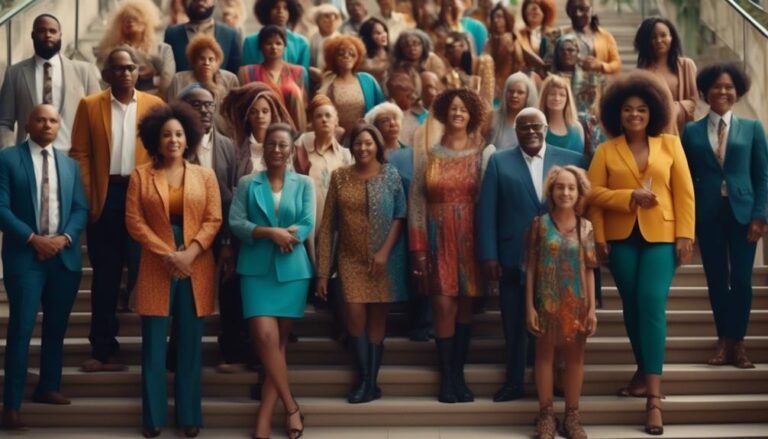Best Practices for Recruiting a Diverse Workforce
In today's globalized and interconnected world, fostering diversity and inclusion within the workforce has become an essential aspect of an organization's success.
However, recruiting a diverse workforce is not merely a matter of chance; it requires a strategic and intentional approach.
By adopting best practices, organizations can attract and retain a diverse range of talented individuals, bringing fresh perspectives and ideas to the table.
In this article, we will explore key strategies that organizations can employ to create a more inclusive workplace, enhance productivity, and ultimately achieve a competitive edge in the ever-evolving business landscape.
Key Takeaways
- Developing a comprehensive diversity training program that addresses unconscious biases and promotes cultural competence is essential for building a diverse and inclusive workforce.
- Building partnerships with universities, professional associations, and community organizations can help expand recruitment channels and reach diverse candidates.
- Implementing unbiased hiring practices, such as blind screening processes and structured interviews, can help ensure fair and inclusive talent acquisition.
- Leveraging employee referrals, incentivizing diverse referrals, and tracking and measuring diversity referrals can be effective strategies for attracting diverse talent.
Developing a Diversity and Inclusion Strategy
Developing a comprehensive diversity and inclusion strategy is crucial for organizations seeking to foster a more inclusive and equitable work environment. One key aspect of this strategy is developing a diversity training program. This program should aim to educate employees on the importance of diversity and inclusion, provide tools and resources to promote inclusive behaviors, and address any unconscious biases that may exist within the organization.
A well-designed diversity training program should be interactive, engaging, and tailored to the specific needs of the organization. It should promote understanding and empathy among employees, and equip them with the skills necessary to create a more inclusive workplace. This can include topics such as cultural competence, unconscious bias awareness, and inclusive leadership.
In addition to developing a diversity training program, organizations must also establish mechanisms for measuring diversity and inclusion progress. This can be done through regular assessments and surveys that gauge employee perceptions and experiences. By collecting and analyzing this data, organizations can identify areas for improvement and track progress over time.
Measuring diversity and inclusion progress is essential for holding organizations accountable and ensuring that efforts to promote diversity and inclusion are effective. It allows organizations to identify any gaps or challenges that may exist and develop strategies to address them. Regular assessments also provide an opportunity for employees to provide feedback and contribute to the ongoing improvement of the diversity and inclusion strategy.
Building a Diverse Talent Pipeline
To build a diverse talent pipeline, organizations must implement proactive strategies to attract and recruit individuals from underrepresented groups. This involves talent acquisition and outreach strategies that are specifically designed to engage with diverse candidates and encourage their interest in the organization. Here are four key strategies that organizations can employ:
- Develop partnerships: Collaborate with organizations and institutions that have connections to underrepresented groups. This can include universities, professional associations, and community organizations. By establishing partnerships, organizations can tap into existing networks and access a wider pool of diverse talent.
- Expand recruitment channels: Traditional recruitment methods may not reach diverse candidates effectively. To broaden the talent pool, organizations should explore alternative channels such as job boards that cater to specific demographics, social media platforms, and diversity-focused career fairs. This will help to attract candidates from different backgrounds and experiences.
- Implement targeted marketing: Tailor recruitment materials and messages to resonate with underrepresented groups. Highlight the organization's commitment to diversity and inclusion, and showcase success stories of diverse employees. By showcasing a welcoming and inclusive culture, organizations can attract diverse candidates who can envision themselves thriving within the organization.
- Provide unconscious bias training: Unconscious bias can hinder the recruitment of diverse candidates. Organizations should provide training to their hiring managers and recruiters to increase their awareness of biases and how to mitigate them. This will ensure fair and inclusive hiring practices throughout the talent acquisition process.
Implementing Unbiased Hiring Practices
To ensure a fair and inclusive talent acquisition process, organizations must implement unbiased hiring practices that minimize the impact of unconscious bias. Unconscious bias refers to the stereotypes, prejudices, and assumptions that individuals unknowingly hold and influence their decision-making. These biases can affect the selection process and hinder the organization's ability to build a diverse workforce.
Organizations can implement several strategies to mitigate unconscious bias and ensure fair selection. First, they can establish clear and objective criteria for evaluating candidates, focusing on relevant skills, qualifications, and experiences. This helps eliminate subjective judgments based on personal biases.
Second, organizations can implement blind screening processes, where identifying information such as name, gender, and ethnicity is removed from resumes and applications. This practice allows hiring managers to focus solely on the qualifications of the candidates, promoting fair evaluation.
Furthermore, organizations can provide unconscious bias training to recruiters and hiring managers. This training helps increase awareness of biases and provides strategies to minimize their influence on decision-making. It also encourages the use of structured interviews and assessment tools to ensure consistency and fairness in the selection process.
Implementing unbiased hiring practices is crucial for organizations striving to build a diverse workforce. By minimizing the impact of unconscious bias, organizations can create a fair and inclusive talent acquisition process that attracts and retains a diverse pool of candidates.
Leveraging Employee Referrals for Diversity
Leveraging employee referrals for diversity can be an effective strategy for organizations looking to build a diverse workforce. Referral networks can help tap into a wider pool of candidates from different backgrounds and experiences.
To incentivize diverse referrals, companies can offer rewards or bonuses specifically for referrals that lead to the hiring of underrepresented individuals, thereby encouraging employees to actively participate in the effort to create a more inclusive workplace.
Referral Networks for Diversity
Utilizing employee referrals as a means to enhance diversity within the workforce is an effective strategy for organizations seeking to foster a more inclusive environment. By leveraging the personal networks of their employees, companies can tap into a wider pool of potential candidates from diverse backgrounds.
Here are four ways organizations can leverage referral networks for diversity:
- Establish referral incentives: Offering rewards or bonuses to employees who refer diverse candidates can incentivize them to actively seek out individuals from underrepresented groups.
- Implement outreach programs: Organizations can collaborate with employee resource groups or partner with external organizations to create targeted outreach programs that focus on attracting diverse talent.
- Train employees on unconscious bias: Providing training to employees on unconscious bias can help ensure that referrals are based on merit and not influenced by biases or stereotypes.
- Track and measure diversity referrals: By tracking and analyzing the diversity of referrals, organizations can identify any biases in the referral process and make necessary adjustments to ensure equal opportunities for all candidates.
Incentivizing Diverse Referrals
Implementing a rewards program for employees who refer diverse candidates can effectively incentivize the recruitment of a more inclusive workforce. By offering incentives, such as cash bonuses, gift cards, or extra vacation days, organizations can encourage their employees to actively participate in the effort to diversify the workplace.
This approach leverages the power of employee referrals, which have been proven to be a highly effective recruitment strategy. To maximize the impact of the rewards program, organizations can also host diversity recruitment events and engage with employee resource groups.
These events provide opportunities for employees to network with diverse professionals and learn about potential candidates. Employee resource groups, on the other hand, can serve as a valuable source of referrals, as they are often comprised of individuals from various backgrounds who can recommend qualified candidates.
Utilizing Diversity-Focused Job Boards and Networks
To effectively recruit a diverse workforce, it is essential to tap into specific job boards and networks focused on promoting diversity and inclusion. Here are four strategies for utilizing diversity-focused job boards and networks:
- Targeted outreach: Actively seek out job boards and networks that cater to diverse candidates. These platforms often have a built-in audience of individuals from underrepresented backgrounds who are actively looking for opportunities. By posting your job openings on these platforms, you can increase your chances of attracting diverse talent.
- Diversity recruitment marketing: Create targeted marketing campaigns that highlight your commitment to diversity and inclusion. Use these campaigns to promote your job openings on diversity-focused job boards and networks. Emphasize your company's inclusive culture, diverse leadership, and employee resource groups to attract candidates who value diversity.
- Partnerships and collaborations: Establish partnerships with diversity-focused organizations, professional associations, and affinity groups. These partnerships can provide access to their networks and allow you to tap into a pool of qualified candidates from diverse backgrounds. Collaborate with these organizations to host events, webinars, or workshops to engage with potential candidates.
- Internal referrals and employee resource groups: Encourage your employees to refer diverse candidates from their networks. Employee resource groups (ERGs) can also play a crucial role in connecting with diverse candidates. Leverage the knowledge and connections of these groups to identify qualified individuals and promote your job openings.
Creating an Inclusive Onboarding and Retention Process
Creating an inclusive onboarding and retention process is crucial for organizations aiming to cultivate a diverse workforce.
An effective employee orientation program ensures that new hires feel welcomed, supported, and informed about the company's values and goals.
Ongoing support and development opportunities further contribute to employee engagement and retention by fostering a sense of belonging and promoting growth within the organization.
Effective Employee Orientation
Establishing an inclusive onboarding and retention process is essential for ensuring the successful integration and long-term engagement of a diverse workforce. To create an effective employee orientation program, organizations should consider the following:
- Clear Communication: Provide new hires with comprehensive information about the company's mission, values, and expectations. This helps them understand their role and responsibilities, fostering employee engagement from day one.
- Cultural Sensitivity Training: Offer training sessions that promote cultural integration and sensitivity. This helps employees understand and respect different backgrounds, creating a more inclusive work environment.
- Mentorship Programs: Pair new employees with experienced mentors who can guide them through the onboarding process. This not only helps new hires feel supported but also facilitates knowledge transfer and relationship building.
- Ongoing Support: Provide ongoing support and resources to employees throughout their tenure. This could include regular check-ins, training opportunities, and career development programs, enhancing employee engagement and retention.
Ongoing Support and Development
Developing a strong support system and fostering continuous growth and development are key components of creating an inclusive onboarding and retention process for a diverse workforce.
To ensure ongoing support and development, organizations should provide regular training opportunities that address the specific needs and challenges faced by diverse employees. Ongoing training programs can help employees enhance their skills, stay updated with industry trends, and foster a sense of belonging within the organization.
Additionally, implementing mentorship programs can offer valuable guidance and support to diverse employees, helping them navigate their career paths and overcome any barriers they may encounter.
Conclusion
In conclusion, building a diverse workforce requires a strategic approach. This approach encompasses developing a diversity and inclusion strategy. It also involves building a diverse talent pipeline and implementing unbiased hiring practices. Additionally, organizations can leverage employee referrals and utilize diversity-focused job boards and networks. Finally, creating an inclusive onboarding and retention process is crucial.
By incorporating these best practices, organizations can foster an environment that celebrates and harnesses the unique perspectives and talents of individuals from diverse backgrounds. This ultimately leads to a more harmonious and successful workplace. Like a tapestry woven with various threads, a diverse workforce enriches the fabric of an organization. It brings forth innovation, creativity, and strength.







